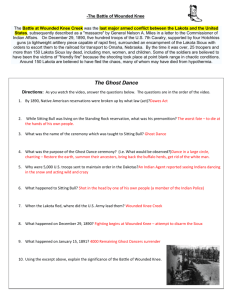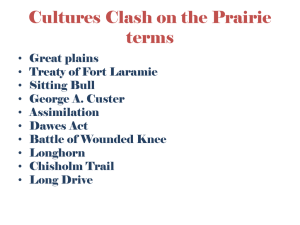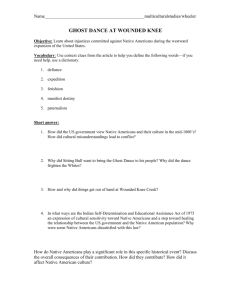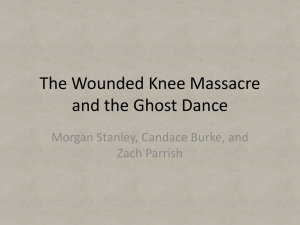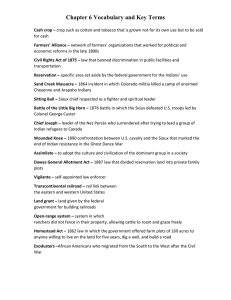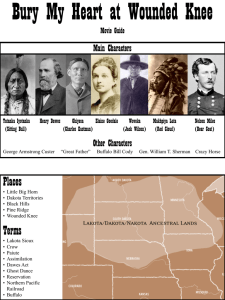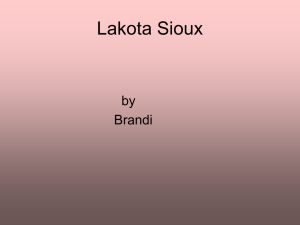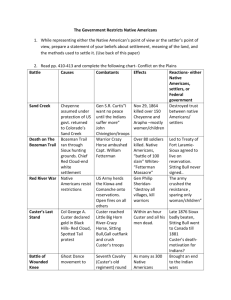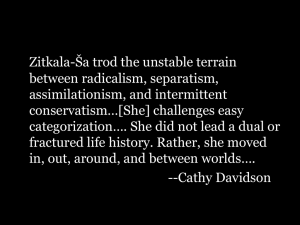Battle of the Little Big Horn
advertisement
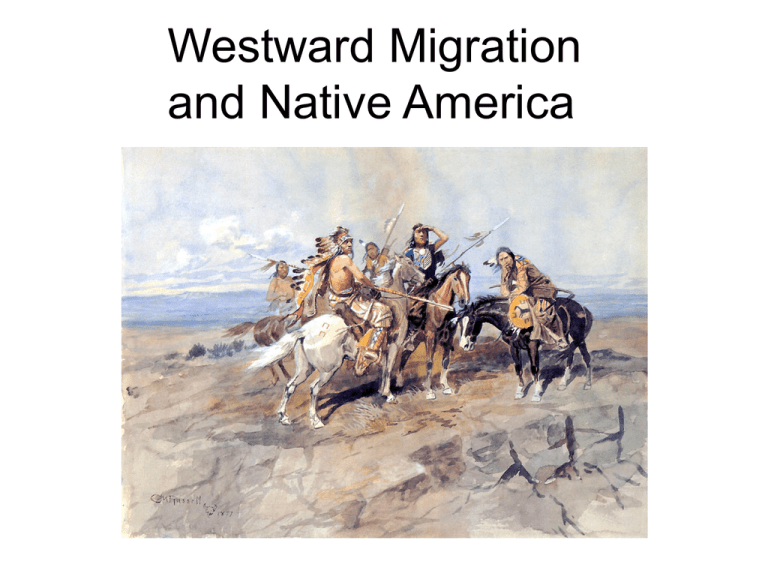
Westward Migration and Native America Arrival of First Native Americans Evidence suggests that the first humans crossed the Bering Strait more than 10,000 years ago. Spread Across the Americas As a result of eastern settlement, Native Americans were pushed west of the Mississippi River and into the Oklahoma Territory. Most of those that remained in the east were settled on reservations. Lakota Culture The Lakota, along with the Dakota and Nakota were an important sub-tribe of the Sioux. They settled in what is now North and South Dakota. The Lakota mastered their environment by taking advantage of the horse, introduced to North America by the Spanish sometime in the early 1500’s and adopted by the Lakota in the 1700’s. Painting – George Caitlin Importance of the Buffalo Plains Indians were intensely reliant upon the buffalo for survival. There were estimated to be some 4 million buffaloes on the plains in the early 19th century. That number dropped drastically by the end of the century to a few tens of thousands. Religion and Ceremony The Sioux believed in an allpowerful god Wakan Tanka (“Great Mystery”). They often utilized ceremony to mark initiation or communication with spirits, or to prepare for battle. Most notable were the Sun Dance, the Buffalo Dance and the Ghost Dance. The Sioux made frequent use of the sacred pipe within the tribe and to honor alliances. Great Westerns Westward Migration The 1862 Homestead Act passed by Congress offered qualified White Settlers free land (160 acres each) west of the Mississippi. Traffic through Lakota and Cheyenne territory picked up further with the establishment of the Oregon and Bozeman Trails. Photo – National Archives Red Cloud The White Man has made many promises, but kept only one – the promise to himself to take all our land. - Red Cloud, Sioux Chief From 1862-1868, Red Cloud, chief of the Oglala Sioux led a series of raids against settlers and miners heading west. Dances With Wolves Dances with Wolves is a 1990 film starring and directed by Kevin Costner. Set in the year 1863, the film tells the story Union Lt. John Dunbar’(Costner) who wishes to see the American frontier before it is gone. After performing a heroic act in a skirmish with Confederate soldiers, Dunbar’s reward is an assignment in desolate Fort Sedgwick, Colorado so he can have a chance to see the prairie “before it is gone”. Ultimately, Dunbar befriends Sioux Indians and gets mixed up in their rivalry with the Pawnee. The film draws upon several techniques in the tradition of great Hollywood Westerns, yet includes some groundbreaking techniques as well. The Road to Little Big Horn Most notable of the broken treaties made to the Sioux was the Fort Laramie Treaty of 1868, which promised the Black Hills region of South Dakota, “Paha Sapa” a sacred ground, to be set aside as Sioux land, in exchange for Sioux settlement on the reservations and cessation of attacks against whites. In 1874, gold was found in the Black Hills and Pres. Grant (“Great Father”) signed an order to remove the Sioux, leading to renewed hostilities. Battle of the Little Big Horn In 1876, the War Department sent General George Armstrong Custer to remove the Sioux from the Black Hills and place them on the Sioux reservation. What followed was one of the most monumental battles ever fought on U.S. soil – The Battle of Little Big Horn. General George General George “Three Stars” Crook Armstrong Custer On June 25th, Custer along with more than 200 men from the 7th Cavalry were killed by Sioux fighters led by Hunkpapa Sioux chief Sitting Bull and Ogala Sioux leader Crazy Horse. Sitting Bull Gall, Lakota Chief Sitting Bull The Ghost Dance and the Killing of Sitting Bull In the winter of 1890, at a time when no hope was left, testimony was brought to Sitting Bull of a Paiute Indian named Wavoka, who claimed to be the reappearance of Christ, and prophesized the coming victory of Indians over whites, if they honored the ancestors by performing the Ghost Dance. Wavoka Sitting Bull Sitting Bull was later labeled as an advocate of the Ghost Dance, and an arrest warrant was issued for him. The attempt to take him into custody led to a scuffle, which cost his life. The Ghost Dance The Ghost Dance The Ghost Dance by the Oglala Lakota at Pine Ridge. Illustration by Frederic Remington, 1890. http://www.youtube.com/watch?feature=pla yer_embedded&v=DIuZVkVJWQo The Battle of Wounded Knee The last battle between the Sioux and the U.S. Army was the Battle of Wounded Knee - Dec. 28th, 1890. The cause was homesteaders fears of Sioux rebellion inspired by the Ghost Dance, a dance taught by some militant leaders. Initially the army was sent in to move the Sioux from the Pine Ridge area of South Dakota. An agreement was struck, but fighting erupted when the army demanded the Sioux surrender all weapons. Some 300 Sioux, including their leader Big Foot were killed. Wounded Knee victim – Legends of America Activity: Read the following excerpts from Dee Brown’s Bury My Heart at Wounded Knee Battle at Little Big Horn. P. 287 “In the Geese Laying Moon … – p. 296 “Low Dog Said”. (Note: fuller account - P. 284 – P. 297.) Upon reading: • Trace the sequence of events leading up to the Battle of Little Big Horn • Cite actions that distinguished the leaders Sitting Bull and Crazy Horse • Contrast different accounts of the manner in which Custer was killed Account of the Ghost Dance and the Battle at Wounded Knee – P. 431 “In the drying grass moon … through p. 438./ P. 439 – 445 – entire chapter. Upon reading, recall the author’s account of the events leading up to the death of Sitting Bull and the Battle of Wounded Knee. Also explain why this battle represents a monumental turning point in American history. Essential Question: Was the conquest of the Plains Indian inevitable? Painting of Crazy Horse by Michael Gentry– Note: Crazy Horse never sat for any portraits or allowed any photos to be taken of him during his lifetime. Stolen Horses by Charlie Russell Red Cloud, George Caitlin National Gallery Mid 19th cent. George Caitlin’s Buffalo Hunt Bibliothèque Nationale, Paris, France George Caitlin By William Fisk 1849 Epilogue
